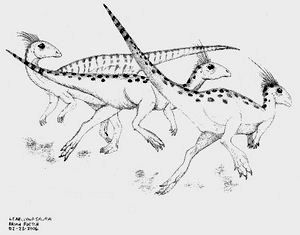ShopDreamUp AI ArtDreamUp
Deviation Actions
Suggested Deviants
Suggested Collections
You Might Like…
Description
PRONOUNCED Lee-ell-lin-ah-saw-rah
MEANING Leaellyn's reptile
CLASSIFICATION Hypsilophodontidae, Euornithopoda, Ornithopoda,
Cerapoda, Ornithischia
AGE Early Cretaceous (Albian) 106 MYA
FORMATION Otway Group
Referred specimens: Strzelecki Group
SIZE 1 metre (3 feet) long
LOCATION Dinosaur Cove, Victoria
Leaellynasaura was a bipedal herbivorous hypsilophodontid, and in my opinion the cutest dinosaur of them all. It was named after Leaellyn Rich, the daughter of palaeontologists Tom Rich and Patricia Vickers-Rich. It is one of many dinosaurs whose partial remains have been dug (and blasted) out of the solid sand- silt- and mud-stones of Dinosaur Cove in the south east of Australia. The holotype for Leaellynasaura (NMV P185990-3) is a partial skeleton with an almost complete skull, and many small isolated bones have also been attributed to Leaellynasaura sp. The holotype is of a juvenile about 75 cm (2.5 feet) long and 30 cm (1 foot) high, although adults probably reached almost 1 metre (3 feet) in length. The reconstruction shown here is of the juvenile type specimen.
Hypsilophodontids probably fed on ferns and horsetails that grew in the under story of the forest. Perhaps they also scrambled into the trees, in much the same way as goats do, but they weren't really built for climbing. The polar forest that Leaellynasaura lived in included conifers (like araucarians and podocarps), and ginkgo trees. Flowering plants would have been extremely rare, and probably restricted to small ground plants, which hypsilophodonts may also have eaten.
During the Early Cretaceous southern Australia was joined with Antarctica, and would have had 3 to 5 months of complete darkness each year (see polar dinosaurs). The fact that dinosaur remains are here at all, and also to be found in the Arctic, suggests that their metabolism was probably not like modern reptiles. An enlarged optic lobe in an excellently preserved endocast of the brain may indicate that Leaellynasaura was well adapted to living for extended periods in the winter darkness (an endocast is formed when sediment fills the cavity inside a skull where the brain has rotted away, and solidifies to form a natural cast of the brain itself).
Credit to: [link]
Drawn by: Brian Roesch.
Other information:
Rich, T.H. and [link] 1988. A juvenile dinosaur brain from Australia. National Geographic Research. 4(2):148.
Galton, P. M. 1989 Crania and endocranial casts from ornithopod dinosaurs of the families Dryosauridae and Hypsilophodontidae (Reptilia: Ornithischia). Geologica et Palaeontologica 23: 217-239
Rich, T.H. and [link] 1989 Polar dinosaurs and biotas of the Early Cretaceous of southeastern Australia. National Geographic Research 5:15-53.
Rich, T.H. & P.Vickers-Rich 1999 The Hypsilophodontidae from Southeastern Australia In Y.Tomada, [link] and P.Vickers-Rich (Eds) Proceedings of the Second Gondwana Dinosaur Symposium. National Science Museum Monographs, No.15. Tokyo. pp.167-180
MEANING Leaellyn's reptile
CLASSIFICATION Hypsilophodontidae, Euornithopoda, Ornithopoda,
Cerapoda, Ornithischia
AGE Early Cretaceous (Albian) 106 MYA
FORMATION Otway Group
Referred specimens: Strzelecki Group
SIZE 1 metre (3 feet) long
LOCATION Dinosaur Cove, Victoria
Leaellynasaura was a bipedal herbivorous hypsilophodontid, and in my opinion the cutest dinosaur of them all. It was named after Leaellyn Rich, the daughter of palaeontologists Tom Rich and Patricia Vickers-Rich. It is one of many dinosaurs whose partial remains have been dug (and blasted) out of the solid sand- silt- and mud-stones of Dinosaur Cove in the south east of Australia. The holotype for Leaellynasaura (NMV P185990-3) is a partial skeleton with an almost complete skull, and many small isolated bones have also been attributed to Leaellynasaura sp. The holotype is of a juvenile about 75 cm (2.5 feet) long and 30 cm (1 foot) high, although adults probably reached almost 1 metre (3 feet) in length. The reconstruction shown here is of the juvenile type specimen.
Hypsilophodontids probably fed on ferns and horsetails that grew in the under story of the forest. Perhaps they also scrambled into the trees, in much the same way as goats do, but they weren't really built for climbing. The polar forest that Leaellynasaura lived in included conifers (like araucarians and podocarps), and ginkgo trees. Flowering plants would have been extremely rare, and probably restricted to small ground plants, which hypsilophodonts may also have eaten.
During the Early Cretaceous southern Australia was joined with Antarctica, and would have had 3 to 5 months of complete darkness each year (see polar dinosaurs). The fact that dinosaur remains are here at all, and also to be found in the Arctic, suggests that their metabolism was probably not like modern reptiles. An enlarged optic lobe in an excellently preserved endocast of the brain may indicate that Leaellynasaura was well adapted to living for extended periods in the winter darkness (an endocast is formed when sediment fills the cavity inside a skull where the brain has rotted away, and solidifies to form a natural cast of the brain itself).
Credit to: [link]
Drawn by: Brian Roesch.
Other information:
Rich, T.H. and [link] 1988. A juvenile dinosaur brain from Australia. National Geographic Research. 4(2):148.
Galton, P. M. 1989 Crania and endocranial casts from ornithopod dinosaurs of the families Dryosauridae and Hypsilophodontidae (Reptilia: Ornithischia). Geologica et Palaeontologica 23: 217-239
Rich, T.H. and [link] 1989 Polar dinosaurs and biotas of the Early Cretaceous of southeastern Australia. National Geographic Research 5:15-53.
Rich, T.H. & P.Vickers-Rich 1999 The Hypsilophodontidae from Southeastern Australia In Y.Tomada, [link] and P.Vickers-Rich (Eds) Proceedings of the Second Gondwana Dinosaur Symposium. National Science Museum Monographs, No.15. Tokyo. pp.167-180
Image size
300x235px 12.74 KB
© 2006 - 2024 briankroesch
Comments2
Join the community to add your comment. Already a deviant? Log In
From the preview the looked like parasaurolophus.




































